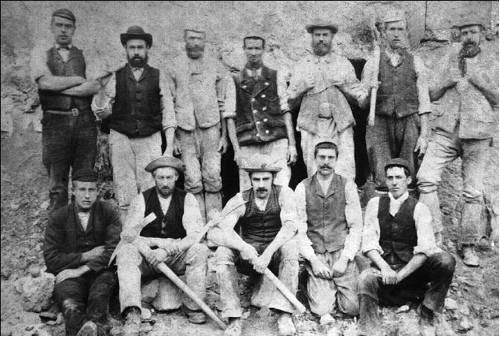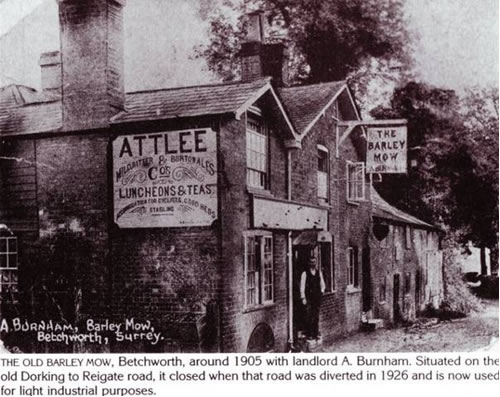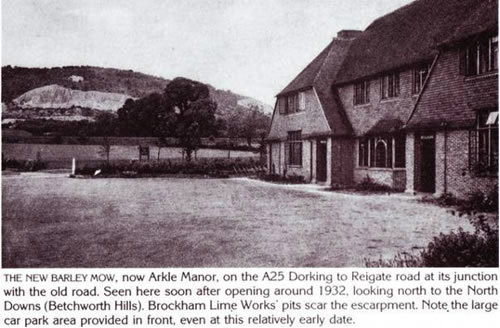General
1851 Census:
Markley Brown Head Widower 86(?) Parliamentary Agent York Beddern
Charlotte Brown Daughter Unmarried 27 Governess Brighton
James Scragg Head Married 47 Gardener to M Brown Cranleigh
Kitty Scragg W Married 33 Ireland (British Subject)
James Richard Scragg S 12 Hants Emsworth
Mary Ann Sophia Scragg D 7 Hants Emsworth
Charlotte Grace Scragg D 5 Hants Emsworth
Caroline Kate Scragg D 9mths Kingston
Brockham Lime and Hearthstone Co. Ltd. remains of an interesting series of lime kilns to a design patented by Alfred Bishop about 1889. The kilns were in use until the 1930s, the hearthstone mines having closed in 1925. Bricks were also produced until about 1910.
There are a number of brick built quarrymen's cottages nearby. Records (leases, accounts, production figures, correspondence etc.) relating to the works are deposited with the Surrey History Centre.
The Brockham firestone quarry and mine-stone workings are an integral part of the lime-works yard and associated brickworks. Monument has now been listed as a Scheduled Monument. The monument includes the remains of Brockham Lime Works situated in the Brockham Hills on the south side of the North Downs. The remains of the lime works include an eastern battery of eight kilns that is Listed Grade II, and a western battery of two kilns.

Lime Burning
Chalk is a form of calcium carbonate which when burnt at about 900 degrees C becomes quicklime (calcium oxide). If water is added it becomes slaked lime (calcium hydroxide) Lime putty is made by adding an excess of water to quicklime. Hydrated lime was being made at most lime-works by the 1950s. Lime putty was used for mortar and plaster, the slaking being done on site. Slaked lime is used as a fertilizer, restoring calcium to the soil, and for building. Quicklime has less pleasant associations, being used to dispose of bodies, particularly in plague pits.
Lime-burning goes back to prehistory. In Britain it was done in Roman times to provide
mortar. There are Saxon references to lime and mortar and in the 12th century walls were whitewashed with lime. It was often made in pits and a clamp using a method akin to charcoal burning and little evidence has been left. By medieval times limekilns were used to produce lime for mortar and by the 16th century there is specific reference to lime being used to improve the soil. This may have been raw chalk or marl and possibly the first reference to a kiln for agricultural lime is in 1603. Up until the 18th century limekilns were temporary structures, built for immediate demand and then allowed to collapse or to be partly rebuilt for the next firing. The agrarian revolution of the 18th century caused an enormous demand for lime and a vast number of kilns were built. Some kilns from this period are still standing. In some areas farmers had their own. If it was relatively easy and economically viable to have chalk delivered from the quarry they made their own lime. Canals later improved transport
The industrial revolution resulted in blocks of kilns being built, capable of continuous
production. By the 20th century mass production had become concentrated at the larger limestone quarries and chalk pits, with economical distribution being made by the railways.
The introduction of Portland cement reduced the demand for simple lime mortar.
With the parallel lines of the North Downs and the Greensand Surrey has produced firestone, hearthstone and chalk for many centuries. As long ago as 1359 John and Philip Prophete were appointed masters of the quarries at Merstham and Chaldon. They were given Letters Patent to dig stone for Windsor Castle and the sheriff was given powers to take any necessary action against any who "refused to assist in the work". In 1805 the best limestone pits in the county - possibly "in the kingdom" - were considered to be at Dorking.
The chalkstone quarries then worked were at Godstone, Caterham, Reigate, Merstham, Buckland, Effingham, West Horsley, Clandon, Guildford and Puttenham. To produce lime six loads of chalk were needed per kiln and this would cost 15/- to 21/-, but the cost to the customer was between £10 and £15, representing the cost of fuel and, particularly, that of transport. The railways brought this price down, but it was still cheaper for farmers near chalk pits to have the raw material delivered and make their own lime.
The kilns had sandstone walls, brick lining for the pot and in a front wall a single arched
draw-hole. A ledge ran round the inside and a wooden frame or iron horse helped the
formation of the initial load of chalk, which would form a dome. Smaller pieces of
chalk were added. A fire was lit under the dome, a modest heat first to dry and set the charge, and then a fierce heat was applied until calcining was complete in 24 to 36 hours, indicated by a clear red fire at the top. After a lengthy cooling period the lime was drawn out. Long handled tools were used for raking and clearing ashes. The complete operation took probably four or five days. The fuel could be a mixture of coal and wood, but locally, in a wooded area, it would be brushwood, coppiced wood or furze.
1881 Census
Charles Lewis Head 55 1826 Labourer Brickyard Greenham, Berks
Ann Lewis Wife 44 1837 Tysoe, Warwickshire
Thomas Lewis son 19 1862 Alderney, Ch.Islands Labourer Brickyard
William Lewis son 14 1867 Leatherhead Labourer Brickyard
James Lewis son 12 1869 Brockham
Ann Lewis dau 8 1873 Brockham
Mary Lewis dau 6 1875 Brockham
Thomas Durham Head 46 1835 Lab. Lime works Tysoe, Warks
Zillah Durham Wife 32 1849 Tysoe, Warks
Walter Durham son 7 1874 Tysoe, Warks
Arthur Durham son 3 1878 Tysoe, Warks
Thomas Smith Head 26 1855 Horley Lab. Lime works
Emily Smith Wife 26 1855 Betchworth
Alfred Stilwell Head 35 1846 Lab. Lime works Sussex
Elizabeth Fanny Stilwell Wife 32 1849 Portsmouth
Elizabeth Maud Stilwell dau 13 1868 Clapham
Jemima Jane Stilwell dau 11 1870 Clapham
Edith Louisa Stilwell dau 8 1873 Clapham
Fredrick Stilwell son 3 1878 Dorking
Mary Mabel Stilwell dau 11mths 1880 Dorking
Charles Butler Lodger 21 1860 Lab. Lime works Cottonbridge, Berks
Charles Archer Head 53 1828 Brickburner Sidmonton, Hants
Olive Archer Wife 70 1811 Brimton, Berks
William Thorpe Head 42 1839 Lab. Lime works Burham, Kent
Charlotte Thorpe Wife 36 1845 Aylesford, Kent
Ellen Thorpe dau 11 1870 Burham, Kent
Friend Thorpe son 9 1872 Jersey, Woodbridge, USA
Rose Thorpe dau 7 1874 Jersey, Woodbridge, USA
Mary Ann Thorpe dau 5 1876 Burham
Sarah Thorpe dau 2 1879 Burham
Olive Maud Thorpe daughter 1 1880 Brockham
Life at the start of the war was "terrible". Boxhill was peppered with incendiaries and high explosives, one exploding in the quarry and a UXB landing at the end of the garden. This was blown up by the army. Ivy recalls her parents being asked to keep all the windows open to lessen damage from the blast. The house didn't have an air raid shelter. Ivy was the only person to sleep upstairs during air raids, accompanied by Bob, the family dog that slept under the bed when he heard planes above. Mum kept the "home fires burning", cooking and caring for all the family. Relatives from London also used to come and stay. It was a "busy" household.
The expansion of Brockham
The main thoroughfare from Reigate to Dorking was the Reigate Road, passing through Betchworth and to the north of Brockham Village and it was not until 1927 the new A25 was built which by-passed the village of Betchworth and Brockham with a line to the south of Boxhill Farm. This improved thoroughfare prompted new housing developments.
To the north of The Borough at the North West end of the Village towards the A25, a large development of individual, architect-designed what would now be called 'executive' homes was established, mostly before the war.
Cottage Farm
Beryl Higgins: Cottage Farm house is early 19th century. A two storey brick and tile-hung cottage; cat-slide roof over a rear two storey outshot all a part of a planned farmyard. Farmyard: A planned farmyard complex: five bay barn, dairy/milking parlour, cow-house with hay loft over, four bay shed - now workshops within a complex named Stony Croft Farm.
Beryl Higgins: A former farm workers cottage built in the 19th century originally a part of the Deepdene Estate within the estate worked from Court Lodge Farm.
The area now known as Puddenhole Cottages on the A25 opposite Brockham Lane and in the 1841 Census it is possible that the below lived in this area.
1841 Census
Joseph Tate 55 Labourer
Elizabeth Tate 45
Mary Tate 20
Sarah Tate 13
John Tate 2
Ann Bollen 20 Housekeeper
John Risbridger 30 Labourer
Mary Ann Risbridger 30
Thomas Risbridger 7
Mary Ann Risbridger 5
Eliza Risbridger 3
Probably same family:
Henry Risbridger 13
John Risbridger 10
Jane Risbridger 8
James Risbridger 5
Mary Risbridger 4
Richard Lisney 50 Labourer
Mary Lisney 50
Mary Lisney 20
Joseph Lisney 13
Jane Lisney 9
John Elliott 20 Labourer
Ester Elliott 20
William Elliott 2
Jane Elliott 6 weeks
Richard Weller 30 Labourer
Harriet Elliott 30
John Sadler 40 Labourer
Sarah Sadler 30
Maria Sadler 12
Thomas Sadler 10
Mary Ann Sadler 8
John Sadler 6
William Sadler 1
Mary Skelton 20
Mary Ann 10 months
Johnson Batchelar 1886: Now I come down the hill passing the two cottages at the side of the Dorking and Reigate main road, the name of Whiting and Sadler. (From the 1881 census, James Whiting, wife Hannah and son George, aged 7)
To John Tate's at Pudding Hole his house (Pudding Hole in the 1881 census, labourer in the Brick Yard) one half in this Parish and the other in Dorking Parish. 70 years ago was the name of Budd, it's on the south side of the South eastern line and South Side of the Dorking and Reigate Road.
I heard my Oldest Brother and My Uncle speaking of their walking the bounds they had to go through Tate's house and then they had to cross one arm of the River Mole, which caused a little amusement as once the Boat Capsized and Caused them to have a good drenching but none was drowned. The men would catch a Boy and bump his bottom against a tree if they found one on the boundary line to make them Remember the Place again.
1881 Census
Puddings Hole
TateHead 48 1833 Lab. Brickyard Brockham
Ann Tate Wife 47 1834 Dorking
Thomas Tate son 18 1863 Lab. Lime works Brockham
George Tate son 16 1865 Lab. Brickyard Brockham
Arthur Tate 13 1868 Brockham
Charles Tate son 10 1871 Brockham
Walter Tate son 7 1874 Brockham
William Henry Tidey Head 33 1848 Farm Lab. Ewhurst
Clara Jane Tidey Wife 29 1852 Brockham
Mary Jane Tidey dau 3 1878 Brockham
William Richard Tidey son 8 mths 1880 Brockham

Taken from "Around Dorking in Old Photographs" Alan Jackson 1989

Taken from "Around Dorking in Old Photographs" Alan Jackson 1989

